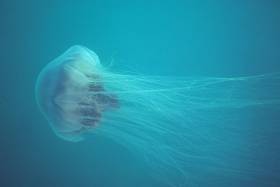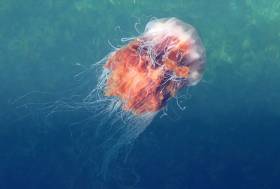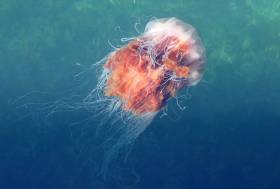Displaying items by tag: lion's mane jellyfish
Diving in for a cool swim after a car journey in warm weather may seem tempting, but it multiplies the risk of drowning, Water Safety Ireland has warned.
As The Sunday Independent reports, the appeal has been issued on the eve of the UN’s first world drowning prevention day – and after six people died in swimming-related incidents over the past week.
“Even if we have slightly cooler weather to come, travelling in a warm car increases the body’s core temperature, “ Water Safety Ireland chief executive John Leech explains.
“This exaggerates the impact of cold shock if one jumps into the water,” Leech says.
 Water Safety Ireland chief executive John Leech
Water Safety Ireland chief executive John Leech
Cold shock can induce uncontrolled breathing which can increase heart rate and blood pressure and cause cardiac arrest.
Water Safety Ireland has appealed to people to swim only in lifeguarded areas or on waterways where there is good local knowledge, with shallow shelving allowing people to remain safely their depth.
It is also reminding people never to use inflatable toys in water, to supervise children closely, to wear a lifejacket when on a leisure craft, and to avoid mixing alcohol with water activities.
Buildings and structures including Dublin Port’s diving bell will be illuminated in blue for UN world drowning prevention day, an initiative that was spearheaded by Ireland and Bangladesh.
Ireland records an average of 115 drownings annually.
In the decade to 2020, drowning was responsible for 1,151 deaths in Ireland - and over 2.5 million preventable deaths worldwide.
During the month of June alone, there were 27 rescues by lifeguards in five counties, according to figures supplied to Water Safety Ireland.
Lion's mane jellyfish
Meanwhile, there have been sightings of Lion's mane jellyfish on the east and west coasts at Malahide in Dublin, Mullaghmore in Sligo and Ballyvaughan, Co Clare.
A sting from a Lion's mane can cause nausea, sweating, cramps and headaches.
A spokesman for Sligo County Council warned that people can get into difficulties from panic caused if stung by one of these particular jellyfish.
Fatalities on inland waters
Five of the six fatalities in the water this week occurred inland.
Jay Moffett (13) died in Scarva, Co Down on Monday after he got into difficulty while swimming with friends, and Killian Casey (15) died in hospital late this week after he was rescued from Lough Sheelin, bordering Cavan, Westmeath and Meath on Tuesday afternoon
A 55-year old man named locally as Peter Jones died in Lough Melvin, Co Fermanagh on Wednesday morning.
On Wednesday evening, 29-year-old mother of two Natasha Corr lost her life at Swan lake outside Gowna village on the Longford-Cavan border.
Also on Wednesday,a man in his seventies named locally as Michael Hoey died in a snorkelling incident at Spencer Harbour, Drumkeeran, Co Leitrim.
A man in his sixties died at Dollymount strand, Dublin, on Friday in a suspected case of cardiac arrest.
Read The Sunday Independent here
Portaferry Coastguard Rescue Team on Strangfrod Lough in Northern Ireland has warned of hundreds of Lion's Mane jellyfish washed up on the shore at Cloughey on the eastern coast of the Ards Peninsula. It's a small village with a beautiful sandy beach.
The team warned that anyone finding a Lion's Mane jellyfish should be aware that the tentacles of this species retain their potent sting long after the jellyfish has died, and dead specimens should therefore never be touched under any circumstances; and that if a dog comes into contact with a Lion's Mane Jellyfish, immediate veterinary attention is advised as anaphylactic reactions are not uncommon.
This jellyfish uses its stinging tentacles to capture, pull in, and eat prey such as fish, zooplankton, sea creatures, and smaller jellyfish and the largest recorded was measured found of the coast of Massachusetts in 1865 and had a bell 7 feet diameter and tentacles around about 120 feet long.
Lion’s Mane Jellyfish Spotted Off Sandycove Prompt Vigilance
Dun Laoghaire-Rathdown County Council has put up warning signs in the lifeguarded area of Sandycove in south Dublin after sightings of lion’s mane jellyfish in the water.
Though the notice was put in place yesterday (Thursday 13 June), it’s emerged there have been sightings of the venomous marine wildlife since mid-May.
Bathing has not been prohibited as it was with the water quality warning earlier this month.
But swimmers at Sandycove and further out in Dublin Bay are advised to proceed with caution for the time being.
As an added precaution the lifeguard warning flags are on red and will remain in place till further notice, the council says.
Lion’s mane jellyfish carry a painful and potentially lethal sting, even when washed up on the beach.
Last summer saw more than 150 lion's mane jellyfish recorded along the West Coast — amid a spate of incidents with swimmers being stung in Galway Bay.
But the East Coast was not immune, as a teenager was hospitalised after he was stung over most of his body off a Co Louth beach.
#Jellyfish - A whopping 157 lion’s mane jellyfish were recorded along the West Coast this summer, according to figures from the National Biodiversity Data Centre.
And as Galway Bay FM reports, more than a third of these sightings (61) were in the Galway area alone.
Swimmers in Galway were first put on alert in June after a number of people were hospitalised by stings from the dangerous marine animal.
Lion’s manes around the Irish coast this year are believed to be larger than usual to due warmers waters as well as an absence of their natural predators.
Meanwhile, the Irish Mirror has news of a ‘ghastly’ find on a Donegal beach in the shape of a partially eaten fish wholly visible inside a jellyfish.
The “savage” remains of what’s thought to be a moon jellyfish — and its final meal — were discovered by Belfast comedian Paddy Raff.
Found this absolute savage of a jellyfish washed up on the beach in Donegal after it had killed and ingested a fish. Even Davy Attenborough would be shook ?#HomicideLifeOnTheBeach pic.twitter.com/bLvUv6RhHt
— Paddy Riff Raff (@paddyraffcomedy) August 27, 2018
Teen Stung By Lion’s Mane Jellyfish Off Louth Beach
#Jellyfish - Ireland’s recent invasion of lion’s mane jellyfish has extended from Galway Bay to the East Coast, where a teenager was hospitalised after a nasty sting in recent days.
Herald.ie reports that 14-year-old Jack Dunne was stung over most of his body after getting entangled in the tentacles of a lion’s mane while swimming with friends off Port Beach, near Togher in Co Louth.
The teen needed “strong antihistamines and anti-inflammatory tablets” to recover from the intense pain of the jellyfish stings, which have the potential to cause death from anaphylactic shock.
Irish Water Safety chief John Leech warned that the dangerous marine species is not normally seen in the Irish Sea till autumn — and may be increased in number due to an absence of their natural predators, sunfish and turtles. Herald.ie has more on the story HERE.
Lion’s mane jellyfish currently being encountered in Irish waters are also larger than usual, according to one animal expert.
Lion’s Mane Jellyfish In Irish Waters Are Larger Than Usual
#Jellyfish - Lion’s mane jellyfish in Irish waters this summer are much larger than usual.
That’s according to zoologist Dr Tom Doyle, who spoke to The Irish Times after a recent spate of incidents that saw swimmers hospitalised by stings from the dangerous marine species in Galway Bay.
“It is not correct to say this is the first time they have been spotted on the west coast, as we had reports for the last two years, but they are particularly large and mature,” said Dr Doyle.
Lion’s mane jellyfish are more commonly seen in the Irish Sea, and reports of larger specimens similar to those off Galway and Clare have come in from North Wales and Liverpool.
Dr Doyle appealed for the public to report any sightings to the National Biodiversity Data Centre as well as the Facebook page for The Big Jellyfish Hunt.
The Irish Times has more on the story HERE.
Jellyfish Wipes Out First Race of Dublin's Junior Sailing Series
#Dublin Bay junior sailors turned up to race yesterday on what was arguably one of the best sailing days of the season so far only to learn the first race of their September Series was scubbed due to 'jellyfish reasons'.
It's just the latest shut down of leisure pursuits in the capitals waters after Dun Laoghaire Rathdown County Council warned against bathing in 'Jelly fish infested waters' at nearby Sandycove.
As a finale to the 2014 season, racing was scheduled for six dinghy classes including the Optimist, Laser Radial and 4.7, Topper, Feva and 420 classes but not even the fact that over 100 junior sailors drawn from the four dun Laoghaire yacht clubs would be on the water rather than in it could stop yesterday's cancellation of the harbour races, such is the risk posed by the Lions mane jellyfish.
Last week Dun Laoghaire Harbour Master Simon Coate wrote to the yacht clubs and classes. ' A considerable number of Lions mane jellyfish have been sighted within the harbour. Please warn your members,' Captain Coate advised.
Dangerous Jellyfish Removed From Dublin Beach
#Jellyfish - The Irish Mirror reported on Friday that 17 dangerous lion's mane jellyfish were removed from Sandycove Beach on south Dublin Bay.
However, that may be just the tip of the iceberg in their numbers as the giant venomous species flocks to Ireland's warming coastal waters from elsewhere in the Irish Sea.
Meanwhile, restrictions on bathing have been lifted from nearby Sandycove Harbour and Killiney Beach after elevated bacterial levels were detected in the water earlier in the week.
Dollymount Strand's temporary bathing ban has also been lifted, as have a number of advisories in North Co Dublin.
However, precautionary notices remain at three locations – Burrow in Sutton, Claremont in Howth and Loughshinny Beach between Rush and Skerries – due to poor results of samples collected from outfalls at those locations.
Michael Viney writes in The Irish Times on growing concerns over lion's mane jellyfish and other harmful species in Irish waters.
The lion's mane is among the largest jellies found in Ireland and comes with a powerful sting, enough to disrupt "the stoical bliss normal to Dublin's Forty Foot bathing cove".
"Last year, the jellyfish was even more abundant in the Irish Sea than in 2009, and sightings from ferries found them from coast to coast," says Viney, who notes their and other jellies' dangerous effects on the marine industry and ocean ecosystems.
The decline of certain plankton-feeding species such as herring due to overfishing, coupled with a rise in sea temperature, has led to a marked increase of jellyfish of many different species in our waters such as the mauve stinger, which is blamed for decimating a Co Antrim fish farm's entire salmon stock.
The Irish Times has more on the story HERE.





































































